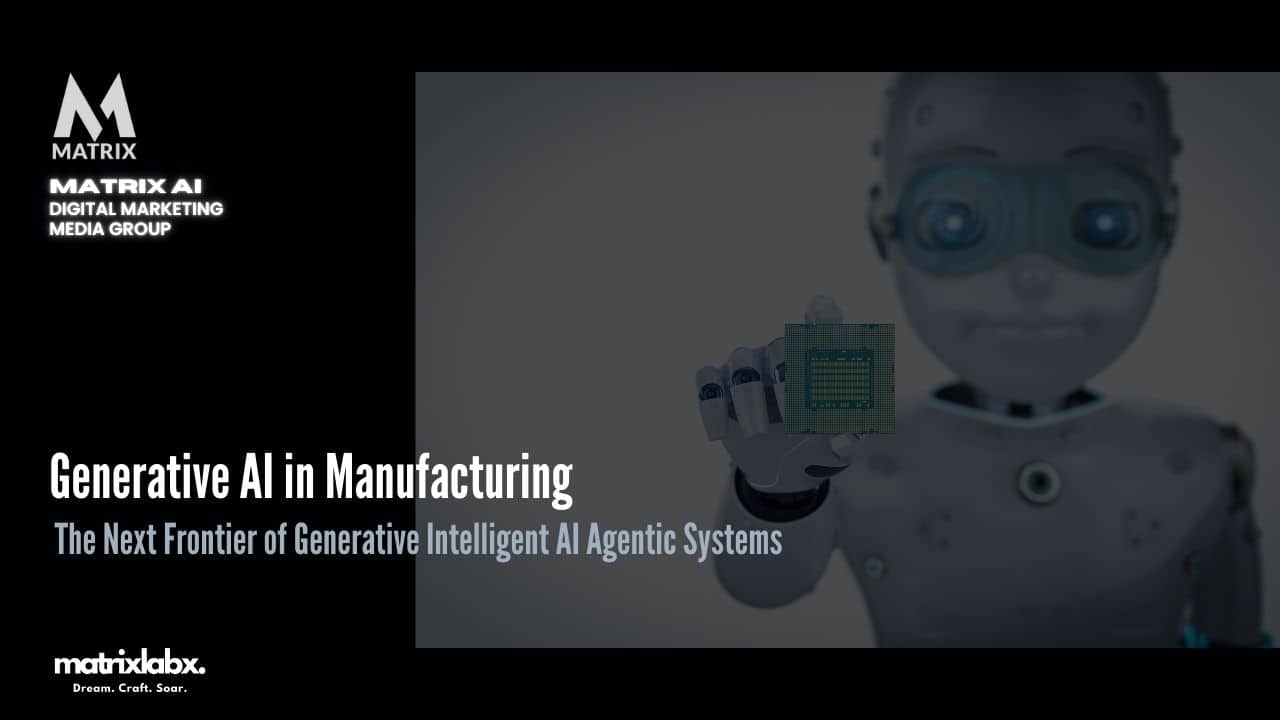Unlocking Efficiency: Generative AI in Manufacturing
The Future of Manufacturing: A Statistical Insight
Generative AI is a beacon of transformation in the rapidly evolving manufacturing landscape.
According to a recent study by Deloitte, companies integrating AI into their manufacturing processes have witnessed a 20% increase in production efficiency and a 30% reduction in operational costs.
These statistics are not just numbers—they testify to AI’s potential to revolutionize the industry.
For marketing managers, understanding and leveraging this technology could be the key to staying ahead in a competitive market.
Addressing Common Concerns: Transparency in AI Adoption
Marketing managers are naturally concerned about adopting generative AI. Questions about implementation costs, integration with existing systems, and the potential for job displacement are common.
However, AI is designed to augment human capabilities rather than replace them. By automating repetitive tasks and optimizing processes, AI frees human resources to focus on innovation and strategic planning.
Transparency is crucial—understanding how AI algorithms work and ensuring ethical use can alleviate fears and build stakeholder trust. Agent as a Service: Faster, Cheaper, and Better Marketing
Your B2B Tech Metrics
Enter your current 12-month averages to analyze your growth potential.
Technology Marketing Analysis
Marketing-Sourced Pipeline
Sales Cycle Length
Lead-to-SQO Conversion
Anonymous Visitor Intelligence
*Goal re-defined as ‘Visitors to Identified Accounts’
Close Your Performance Gap
Matrix Marketing Group combines AI technology with expert services to turn these goals into reality.
Book a Strategy CallEvidence-Based Recommendations for Success
To harness the full potential of generative AI in manufacturing, companies should initiate a pilot project to assess its feasibility and impact.
Collaborating with AI experts and investing in employee training can facilitate a smoother transition. Furthermore, monitoring key performance indicators (KPIs) will provide tangible evidence of AI’s benefits, reinforcing trust in the technology.
By approaching AI integration with a clear strategy and an open mind, marketing managers can lead their companies into a future of increased productivity and innovation.
Understanding Generative AI in Manufacturing
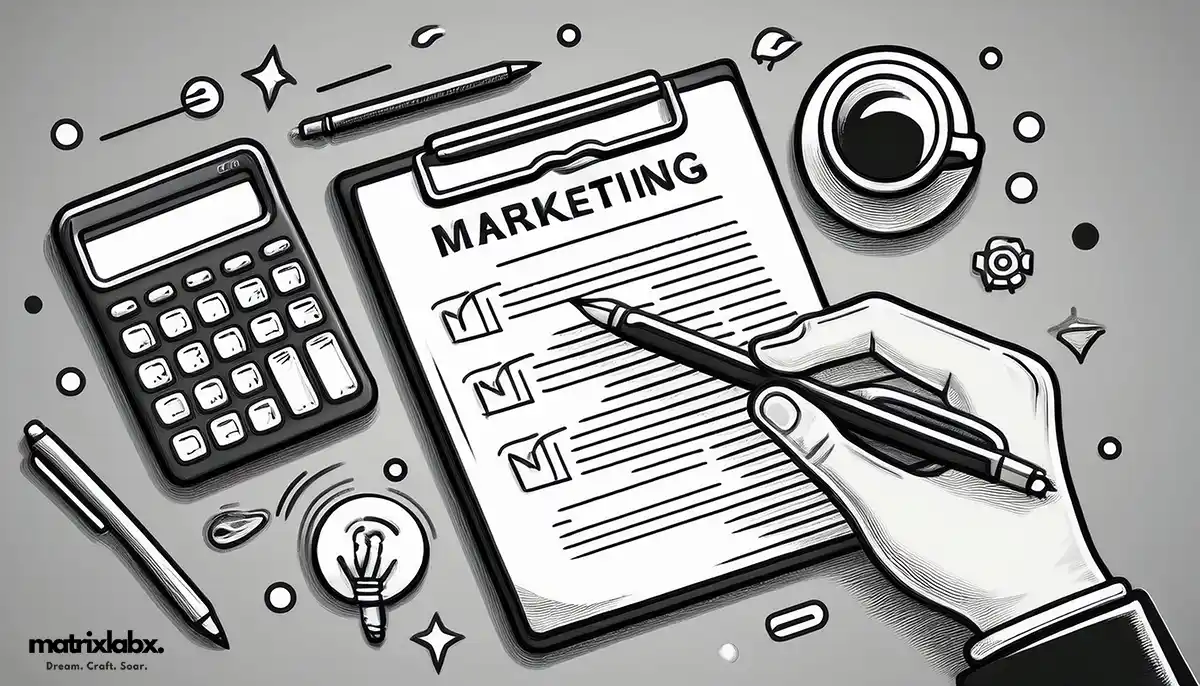
What is Generative AI in Manufacturing?
Generative AI in manufacturing refers to the use of advanced artificial intelligence technologies that create, optimize, and iterate complex designs, processes, and systems to enhance production efficiency and drive innovation.
This cutting-edge technology leverages algorithms to generate ideas, designs, and solutions that are impossible to achieve using traditional methods.
AI can produce novel outputs that drive innovation to unprecedented heights by analyzing vast datasets.
Why is Generative AI Transformative?
Generative AI catalyzes transformation within the manufacturing landscape.
It enables companies to significantly reduce lead times, improve product designs, and lower costs by simulating numerous design permutations and predicting outcomes.
Imagine creating a more sustainable, lightweight, cost-effective product in hours rather than months.
This technology accelerates the design phase and anticipates potential production challenges, ultimately improving market responsiveness and competitiveness.
Where is it impacting the Most?
Generative AI’s influence extends across numerous manufacturing sectors, including automotive, aerospace, and consumer goods.
Marketing managers, in particular, benefit from these advancements by gaining insights that enable strategic decision-making and enhance product positioning.
This AI-driven approach compels marketers to explore beyond conventional boundaries, prompting the question: How can we reimagine our offerings if we reshape our design processes using generative AI?
The potential to redefine products and processes is not just fascinating—it’s a game-changer. Structured AI Outputs: Navigating the Future of Marketing
The Growing Challenge of AI Inexperience in Marketing

Struggling to Keep Up in an AI-Driven World
Marketing managers today face a monumental challenge: successfully integrating AI into their strategies while lacking sufficient experience and expertise.
The rapidly evolving world of AI technology is intimidating for even the most seasoned professionals.
With a clear understanding of AI, marketing managers can stay ahead of competitors who harness these powerful tools to optimize campaigns, analyze consumer behavior, and improve the customer experience.
The anxiety of not knowing how to adopt AI solutions effectively is enough to keep any marketing manager up at night.
The Dangers of Staying Behind
In an era where data and instantaneous insights drive decision-making, a lack of AI experience can be a company’s downfall. Marketing campaigns risk stagnating and disconnecting from consumer needs, leading to wasted resources and dwindling ROI.
Furthermore, without AI-driven analytics, uncovering meaningful customer insights becomes a matter of chance, leaving you at the mercy of guesswork.
The pressure to perform and deliver results without the proper tools can frustrate and overwork marketing teams, creating a cycle of inefficiency and burnout.
Unleash the Power of AI with Our Solutions

Transforming AI Challenges into Opportunities
Our AI marketing solutions are designed to eliminate the guesswork from marketing management.
By providing intuitive, easy-to-use AI tools tailored specifically for marketing professionals, we enable you to transform how your team approaches campaign development, data analysis, and consumer engagement.
Our comprehensive platform empowers you with actionable insights and automation capabilities, freeing valuable time and resources.
Don’t let a lack of AI experience hinder your marketing potential. Let us bridge the gap with a seamless AI integration that drives your business forward and builds your confidence as you navigate the digital marketing landscape.
Embrace the future with solutions that spark creativity and enable smarter marketing strategies. Now is the time to position your brand at the forefront of innovation.
Revolutionizing Manufacturing with Generative AI
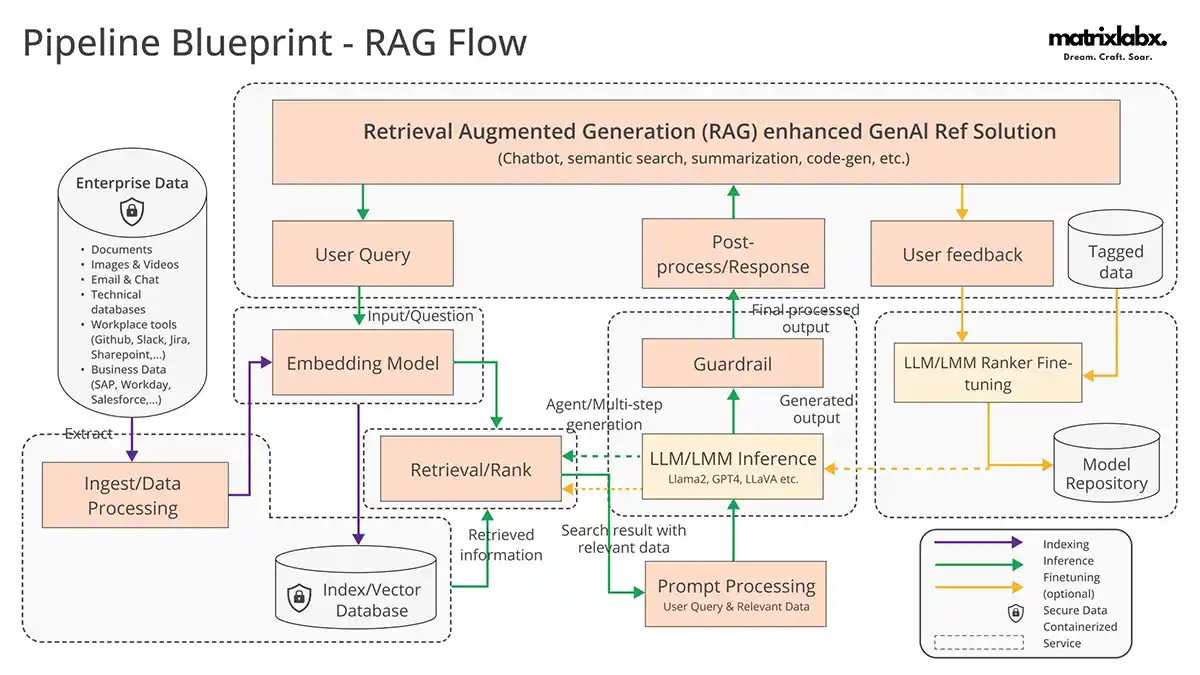
An Expert Perspective
Jessica Lee, a seasoned manufacturing executive with over 25 years in the industry, extols the transformative power of generative AI. “The integration of generative AI into our processes has radically enhanced our production capabilities,” she shares.
“AI algorithms enable us to design efficient supply chains and optimize machinery performance, significantly reducing costs and increasing output. It’s like having fresh eyes that can analyze endless data points and provide actionable insights.”
Jessica’s insight highlights how generative AI can revolutionize production lines, reduce downtime, and improve quality control, making the future of manufacturing efficient and smarter.
A Paradigm Shift in Design
“Generative AI is reshaping our approach to product design,” says Tom Harris, a manufacturing R&D specialist. “By utilizing AI-driven modeling, we can experiment with complex configurations in ways we previously couldn’t conceive.
The AI can iterate designs thousands of times faster than humanly possible, providing sustainable solutions that optimize material usage and product functionality. It’s not just about improving things—it’s about making them in ways we never anticipated.”
Tom’s perspective sparks curiosity about the limitless design possibilities facilitated by AI, urging readers to ponder how these advancements could pave the way for the next industrial revolution.
Driving Marketing Innovation with Generative AI
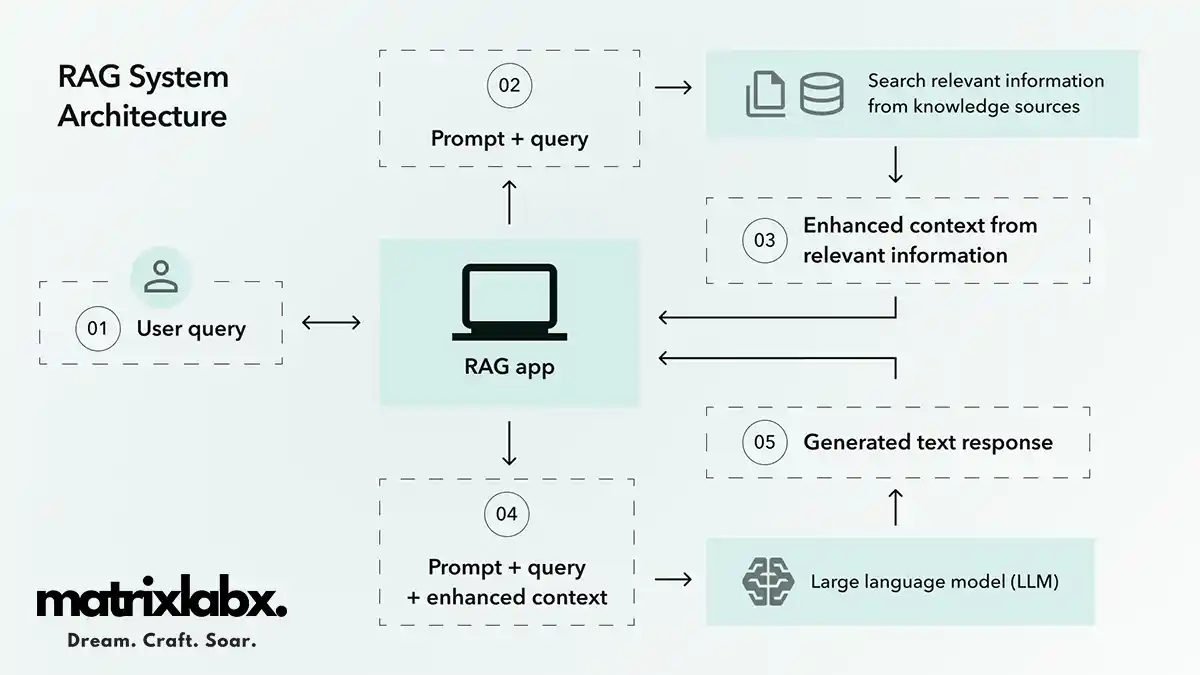
A Marketing Manager’s Insight
“Incorporating generative AI into our marketing strategy has been a game changer,” exclaims Linda Tran, a creative marketing manager from a leading consumer goods company.
“AI tools help us tailor personalized campaigns effortlessly, predicting consumer behavior with stunning accuracy. It allows us to communicate more effectively with our audience by delivering the right message at the right time.”
Linda’s enthusiasm illustrates AI’s potential to redefine engagement tools, encouraging marketers to explore how AI-driven insights can lead to more successful and targeted campaigns.
Crafting the Future of Engagement
Marketing strategist Paul Richards sees generative AI as the key to unlocking customer loyalty and engagement.
“With generative AI, we’re moving beyond demographic-based targeting, utilizing AI’s capacity to analyze customer preferences and interactions in real-time. We can create content that resonates deeply with individuals, keeping us ahead of changing consumer trends,” he explains.
Paul’s assertion invites the reader to imagine new possibilities in consumer relationship building, signifying a bold leap toward more intimate, data-driven marketing landscapes.
The New Frontier: Generative AI in Manufacturing

Generative AI is transforming manufacturing with innovation, adaptability, and efficiency. Manufacturers can simulate, optimize, and create designs that revolutionize complex production processes by leveraging advanced algorithms.
This technology saves time and costs, unearthing new avenues for creativity and customization, and pushes the boundaries of what’s possible within the industry.
Innovative Brands Leading the Way
One example is FluidForm, a Massachusetts-based startup specializing in fabrication and 3D printing.
With generative AI, FluidForm develops intricate and precise scaffolds for tissue engineering, demonstrating how AI can enable groundbreaking manufacturing in the healthcare industry.
This approach exemplifies innovation by marrying artificial intelligence with biology, enabling the production of previously unimaginable organic structures.
Towards a Sustainable Future
Another pioneer is Katafugo, a niche player employing generative AI for recycling and waste management of textiles. Using AI, they design and devise novel methods to reuse discarded fibers, crafting unique, sustainable materials.
This highlights the broader environmental impact that generative AI can have beyond traditional manufacturing, creating opportunities for both ecological responsibility and innovation.
By examining these examples, it’s clear that adopting generative AI in manufacturing facilitates groundbreaking achievements. It enables companies to dream bigger and achieve more while paving the way for a sustainable, intelligently crafted future.
Igniting Innovation: Embracing Generative AI in Manufacturing with Matrix
The need for innovative solutions becomes increasingly paramount in the evolving manufacturing ecosystem.
Generative AI is emerging as a pivotal enabler of creative production strategies. By harnessing Symphony, an AI framework designed to foster collaboration and streamline AI integration, manufacturers can revolutionize their operations.
The journey towards the seamless application of generative AI begins with a structured exploration of Symphony’s capabilities. This ensures that businesses stay ahead of the competition and embrace a future-forward mindset.
Understanding the Foundations: What is a Matrix?
Matrix is a robust, interoperable infrastructure that enables diverse AI models to work cohesively, generating innovative design solutions and optimizing manufacturing processes. The first step in leveraging Matrix for generative AI is to establish a foundational knowledge base.
Engage teams in interactive training sessions to explore Matrix’s features and potential applications in the manufacturing industry.
Encourage curiosity by demonstrating successful use cases from various industries, showcasing how Matrix can transform traditional manufacturing practices into agile, adaptive methodologies.
Laying the Groundwork: Integrating Matrix into Your Workflow
To effectively incorporate Matrix into your manufacturing operations, map out existing production processes. Identify pain points where generative AI could introduce efficiencies or enhance product design.
Collaboration across departments is key—bring engineers, designers, and IT experts together to brainstorm and develop AI-driven solutions.
Utilize Matrix’s integrated toolbox to prototype and test models, ensuring they align with your company’s strategic goals. This collaborative strategy streamlines operations and fosters an inclusive environment for continuous innovation.
Empowering Intelligent Marketing with Multi-Agent RAG Systems
A New Era of AI with Matrix Marketing Group and MatrixLabX
Matrix Marketing Group, in partnership with MatrixLabX, is redefining the future of marketing through next-generation AI capabilities powered by Multi-Agent RAG Systems. This revolutionary approach elevates traditional AI, providing brands with an adaptable, deeply intelligent system for solving marketing challenges and seizing opportunities. Learn more.
Driving Adoption: Inspiring a Generative AI Culture
Educate your workforce about the transformative impact of generative AI and its applications in manufacturing.
Host workshops and seminars that allow employees to engage with AI tools and witness firsthand the potential shifts in production paradigms.
Encourage teams to propose unique applications of generative AI in daily tasks, promoting a shift from traditional methodologies to a culture of innovation and adaptability.
As enthusiasm for AI grows internally, external partnerships with industry leaders can further expand expertise, driving substantial progress in the manufacturing sector.
By initiating the process with Matrix, manufacturers can unlock vast potential in generative AI, resulting in localized improvements and a significant competitive edge in the global market.
Generative AI: Revolutionizing Manufacturing
Generative AI is transforming the manufacturing industry, enhancing efficiency and innovation like never before.
By harnessing artificial intelligence, manufacturers can streamline processes and create complex designs that were previously unimaginable.
Enhancing Efficiency and Design
Generative AI allows for rapidly creating intricate and optimized designs for manufacturing components.
This reduces material waste and significantly shortens design cycles. AI algorithms can analyze vast datasets to generate multiple design options, presenting manufacturers with highly efficient and innovative solutions that meet precise specifications.
This capability has shifted the design paradigm from crafting to computational generation.
Intelligent Production Processes
Beyond design, AI-driven systems optimize production processes through predictive maintenance and real-time monitoring.
By analyzing data from sensors and machines, generative AI can predict equipment failures before they occur, drastically reducing downtime and maintenance costs.
Additionally, AI aids in quality control by rapidly identifying defects, thus enhancing product reliability and customer satisfaction.
Sparking Innovation and Sustainability
Generative AI is leading the charge towards sustainable manufacturing. AI-driven designs contribute to environmentally friendly practices by optimizing resource usage and minimizing waste.
Furthermore, AI fosters innovation by enabling the creation of previously non-viable products, thus paving the way for cutting-edge advancements in aerospace, automotive, and consumer electronics.
Generative AI in manufacturing is not just a buzzword; it’s a catalyst for change, driving profound impacts across the industry. As companies continue to adopt AI technologies, the boundaries of manufacturing will be continually redefined, offering a glimpse into a future filled with endless possibilities and innovation.
The Future and Conclusion
What are AI Agents? A Deep Dive by MatrixLabX Technology
As we move into 2025, we are witnessing a pivotal transformation in artificial intelligence: the rise of AI agents that collaborate with Symphony. Unlike traditional AI models, which often function as static, monolithic systems, AI agents introduce a more dynamic, modular, and interactive approach. This article examines what AI agents are, their distinctive characteristics, and the benefits they offer in complex problem-solving environments.
2025 as the Year of Useful AI Agents
With rapid advancements in artificial intelligence, 2025 is set to be the year of useful AI agents. Traditional AI models, while impressive, are often limited in flexibility, requiring large volumes of data to be effective in narrow applications. By contrast, AI agents can harness diverse data sources, making them versatile and capable of handling complex and dynamic tasks. Instead of being static models that provide a single, unchanging answer, AI agents can think, adapt, and make decisions on the fly. This marks a critical shift toward more personalized and responsive AI applications, empowering organizations to solve unique, evolving problems in ways that traditional models simply cannot.
Shift from Monolithic Models to Compound AI Systems
The transition from traditional monolithic AI models to compound AI systems represents a profound shift in the AI landscape. Monolithic models are often limited by the scope of the data they were initially trained on, which restricts their applicability in new or nuanced situations. For example, a static model trained to recognize images in one context may require assistance when applied to slightly different scenarios, resulting in errors or oversights.
Compound AI systems, however, are designed to be modular, meaning they can combine various components such as databases, models, and logic layers to offer a more adaptable response. Rather than providing a single answer based on limited information, compound systems integrate multiple sources to deliver a response tailored to the specific query. This adaptability makes AI agents highly suitable for real-world applications that demand flexibility and responsiveness.
Understanding Compound AI Systems in the Context of MatrixLabX Products
Understanding Compound AI systems is crucial for marketers as these systems represent the next step in AI-driven marketing solutions. Compound AI systems differ significantly from traditional, single-model AI by combining multiple specialized components, or “modules,” to deliver more intelligent, flexible, and comprehensive solutions. MatrixLabX’s products, including its flagship Symphony Multi-Agentic System, leverage this approach, making them uniquely powerful for marketing departments seeking adaptability and advanced problem-solving.
What is a Compound AI System?
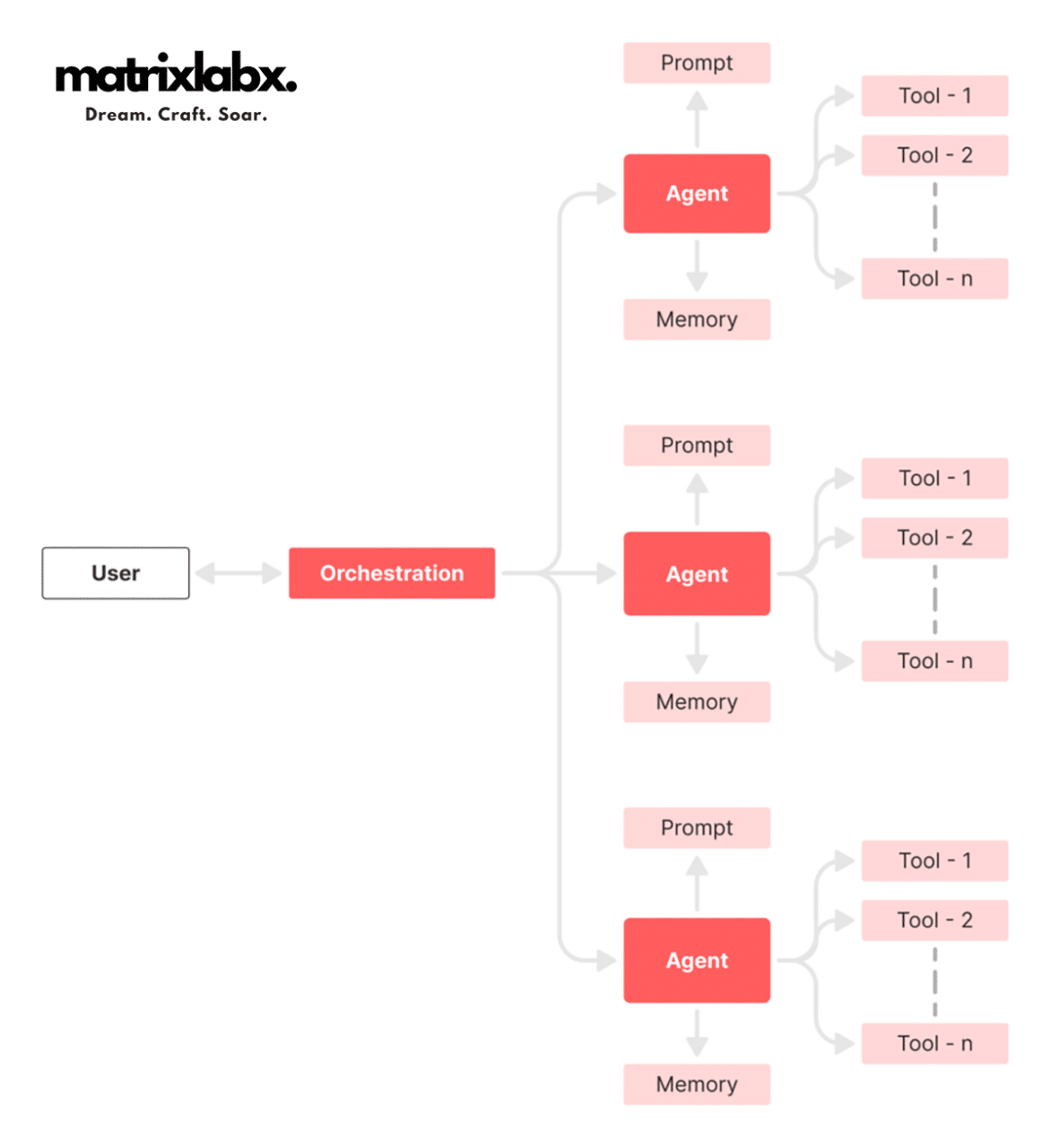
A Compound AI system is a collection of different AI “modules” or “agents” that work together to accomplish complex tasks. Unlike traditional AI models, which are often static and limited to the data they were trained on, compound systems use multiple models, databases, and logic layers to provide a more robust response.
For example, a traditional AI model might only analyze website traffic, but a Compound AI system could combine traffic analysis with customer segmentation, competitor analysis, and predictive modeling. This makes Compound AI systems highly adaptable, allowing them to handle a broader range of tasks while providing insights that a single model couldn’t deliver.
How Compound AI Systems Work
A Compound AI system uses multiple specialized agents that perform different tasks or “skills,” such as data analysis, language processing, or trend forecasting. These agents collaborate and interact with one another, combining their findings to provide a comprehensive solution. Here’s how it works:
- Modular Structure: Each agent is designed for a specific function, like content recommendation, SEO optimization, or lead scoring. This modularity means the system can be customized and scaled to meet the unique needs of different campaigns.
- Data Integration: Rather than relying on a single data source, compound systems can pull data from various sources, ensuring that responses are accurate, up-to-date, and relevant.
- Real-Time Adaptability: Compound AI systems can adjust their approach in response to new data or shifting objectives. If a marketing campaign focuses on a new demographic, for example, the system can quickly reconfigure itself to provide insights into that audience.
MatrixLabX’s Symphony: A Compound AI System in Action
MatrixLabX’s Symphony Multi-Agentic System is a leading example of a Compound AI system tailored specifically for marketing. To solve real-world marketing challenges, Symphony combines AI agents with advanced capabilities like metacognition, neuro-symbolic reasoning, and collaborative intelligence. Here’s how Symphony leverages Compound AI to benefit marketing teams:
- Dynamic Agent Collaboration: Symphony comprises multiple specialized agents designed to handle specific marketing functions. For example, one agent may be dedicated to social media analytics, another to content optimization, and a third to customer segmentation. When a marketing query is received, Symphony dynamically activates the relevant agents, enabling them to collaborate and deliver a unified response.
- Adaptive Intelligence for Evolving Needs: Symphony utilizes a form of AI, known as “self-awareness” (metacognition), which enables it to assess its actions, adapt to new data, and continually refine its approach. This means Symphony doesn’t just deliver a single answer; it evaluates and adjusts its response based on real-time inputs, making it highly adaptable to evolving campaign goals.
- Enhanced Decision-Making with Neuro-Symbolic Reasoning: Symphony incorporates neuro-symbolic reasoning, which combines traditional logical reasoning with deep learning. This enables the system to interpret complex, abstract marketing concepts, such as brand positioning or customer sentiment, and apply them to strategic decision-making. The result is a system that analyzes data and understands context, providing more insightful recommendations.
Benefits of Compound AI Systems for Marketers
Marketers utilize Compound AI systems, such as MatrixLabX’s Symphony, to leverage various benefits that enhance campaign effectiveness and operational efficiency. Here’s how Compound AI systems can revolutionize marketing functions:
- Holistic Campaign Insights: Compound AI systems provide a 360-degree view of marketing campaigns by combining insights from various specialized agents. For instance, Symphony’s agents can analyze customer engagement data alongside competitive positioning and market trends, delivering a comprehensive strategy recommendation beyond what a single AI model could provide.
- Scalable Solutions for Large Campaigns: Compound AI systems can scale effortlessly as campaigns become increasingly complex. Symphony’s modular design allows marketers to add new agents or adjust existing ones to meet the demands of larger campaigns. This makes it easy for marketing teams to expand their campaigns without needing proportional increases in manual effort.
- Improved Personalization: Compound AI systems combine data from multiple sources, enabling marketers to create highly personalized experiences for their audience. Symphony, for example, can analyze customer preferences, past behaviors, and demographic data to deliver targeted content or recommendations that resonate with individual customers, enhancing engagement and driving conversions.
- Enhanced Decision-Making with Contextual Intelligence
Traditional AI models often lack contextual awareness, making them less effective for nuanced decision-making. Compound AI systems, however, excel at interpreting the context around data, enabling them to make recommendations that align closely with business objectives. Symphony’s neuro-symbolic reasoning provides this level of understanding, allowing marketers to make data-driven and contextually relevant decisions. - Cost and Time Efficiency: Compound AI systems save marketers time and reduce operational costs by automating complex tasks that traditionally require multiple tools or team members. Symphony, for example, can independently execute end-to-end campaign analysis, freeing up marketing teams to focus on creative strategy rather than data crunching.
Compound AI Systems as the Future of Marketing
As marketing becomes more data-intensive and complex, the flexibility and adaptability of Compound AI systems will play a crucial role in keeping teams agile and effective. With MatrixLabX’s Symphony, marketers can access a cutting-edge solution combining the best AI technology to deliver deeper insights, enhanced personalization, and smarter decision-making. Symphony is an ideal solution for marketing departments ready to leverage AI’s full potential to drive measurable results.
In the competitive marketing landscape of 2025 and beyond, Compound AI systems like Symphony are set to become invaluable tools, transforming how marketing teams operate and helping them to achieve their goals with precision and efficiency.

